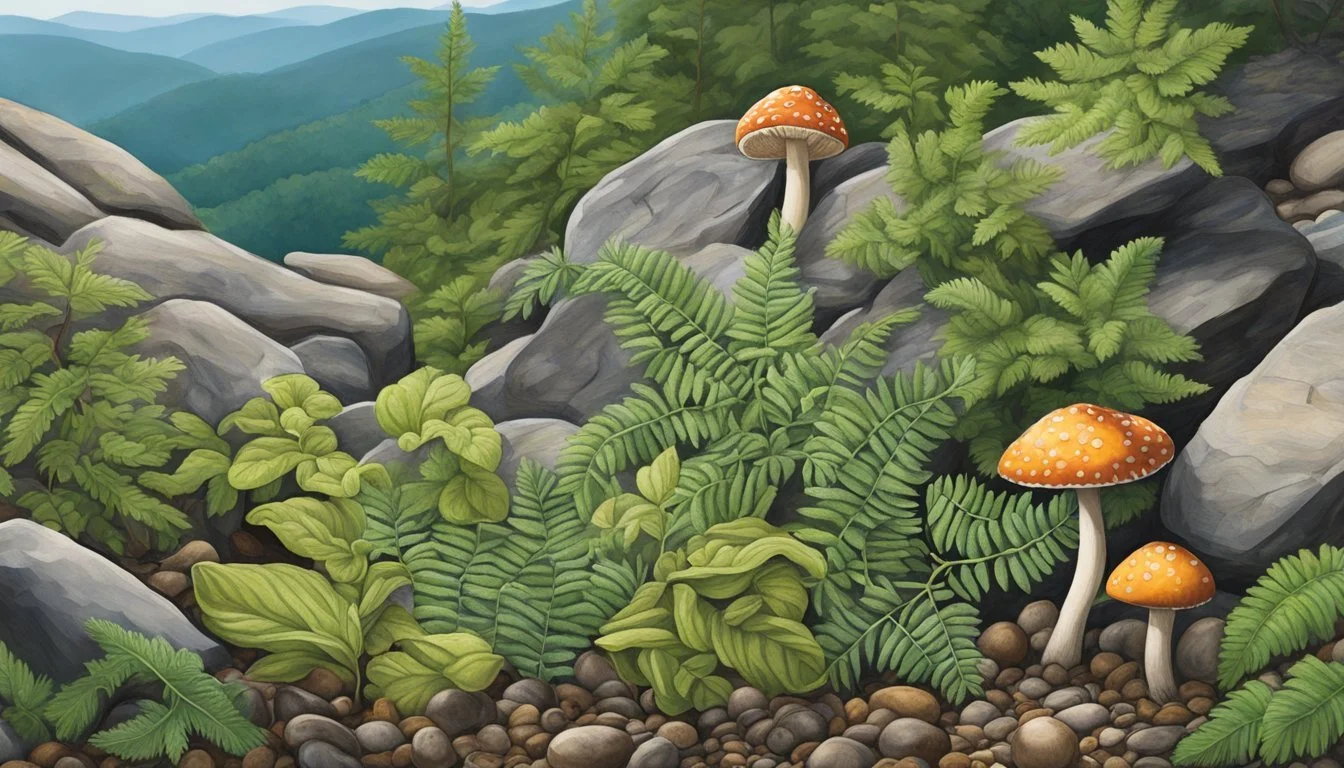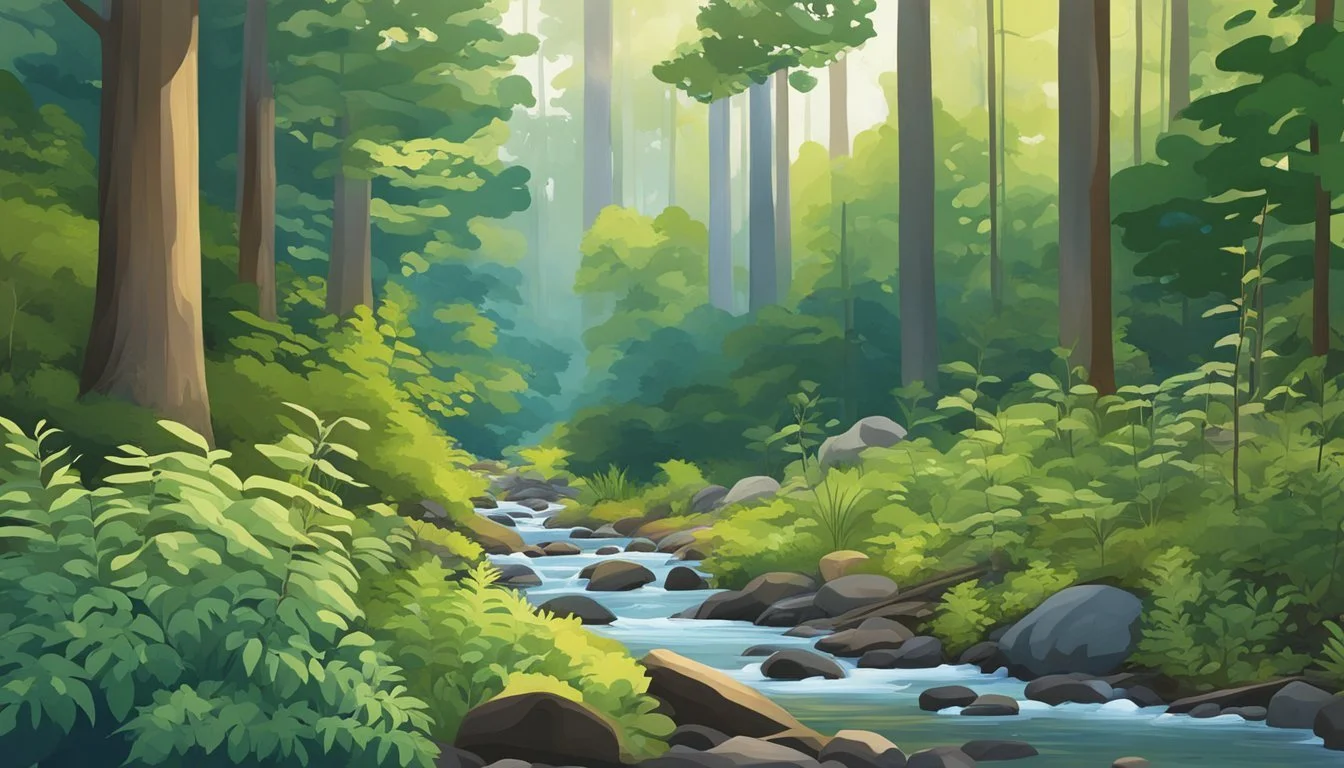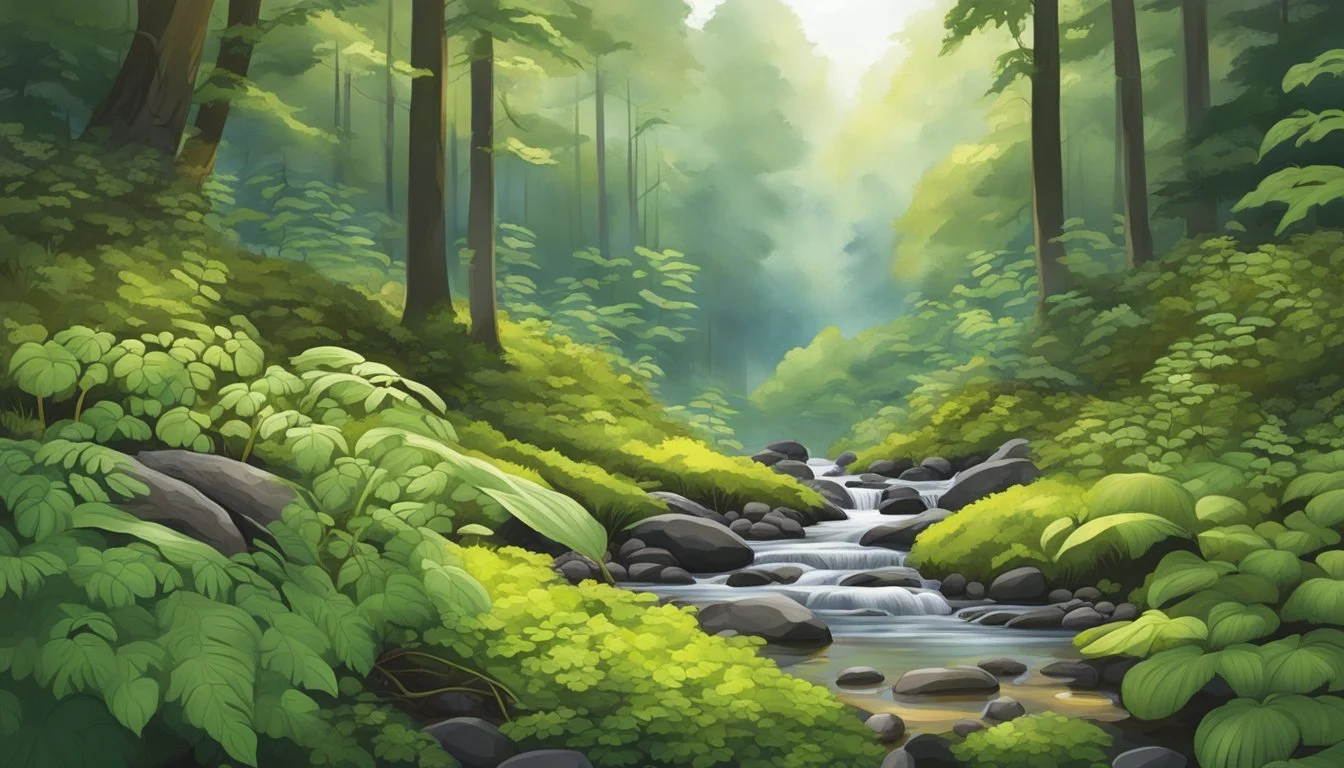Blue Ridge Mountains Native Edible Plants
A Guide to Local Wild Foods
The Blue Ridge Mountains, known for their lush landscapes and rich biodiversity, are home to a vast array of native edible plants. From the sweet berries of the blackberry bush to the nourishing roots and shoots of wild plants, these mountains offer a variety of natural foods that have sustained people for generations. The diversity of plants found here provides not only a culinary adventure but also a connection to the natural world.
For those exploring the Blue Ridge Parkway, the seasonal bounty includes favorites like wild strawberries and sumac. These plants not only add a burst of flavor to the forager's palette but also play a crucial role in the ecosystem, supporting pollinators such as bees and butterflies. By foraging responsibly, visitors can enjoy these delicacies while preserving the environment.
In addition to the widely recognized fruits and berries, the Blue Ridge Mountains also offer unique finds like the Chicken of the Woods mushroom. This vivid orange fungus, growing on the sides of trees, is a memorable and tasty discovery for any forager. With some knowledge and preparation, the Blue Ridge Mountains provide a rewarding foraging experience rich in native flavors.
Understanding the Blue Ridge Mountains Ecosystem
The Blue Ridge Mountains present a unique and diverse ecosystem, characterized by a rich variety of flora and fauna. Understanding the balance between native and non-native species is essential for maintaining the ecological integrity of this region.
Flora Diversity in the Region
The Blue Ridge Mountains are renowned for their incredible plant diversity. This range hosts an estimated 4,000 species of plants, including over 1,400 species of vascular plants. The variety of trees, wildflowers, shrubs, and fungi found here is unmatched, with species uniquely adapted to altitudinal variations ranging from 580 feet to over 6,600 feet.
Among the native plants, you will find oak, hickory, and maple trees dominating the forest canopy. The understory is rich with rhododendrons, mountain laurels, and azaleas. Additionally, numerous wildflowers such as trilliums, violets, and lady’s slippers add vibrant hues to the landscape. This complex web of plant life supports a myriad of animal species, from insects to large mammals, creating a thriving habitat.
Native Species vs. Non-Native Species
The distinction between native and non-native species in the Blue Ridge Mountains is crucial for preserving ecological balance. Native species have evolved over millennia to fit the specific environmental conditions of the area. These include the foundational oak and hickory trees, as well as key wildflowers and shrubs that support local wildlife.
Non-native species, often introduced by human activity, pose significant threats to the native flora and fauna. Invasive plants like kudzu, Japanese honeysuckle, and multiflora rose can outcompete natives for resources, leading to reduced biodiversity. Controlling these invasive species involves early detection, manual removal, and public education to prevent their spread. Efforts to restore and protect native species are ongoing and essential for maintaining the ecological health of the Blue Ridge Mountains.
Identifying Native Edible Plants
Learning to identify native edible plants in the Blue Ridge Mountains can be both rewarding and essential. Key types include leaves and herbs, fruits and berries, and wild edible mushrooms, each offering a variety of nutritious and often delicious options.
Leaves and Herbs
Numerous edible leaves and herbs can be found in the Blue Ridge Mountains. Dandelion leaves, known for their bitter, peppery flavor, are often used in salads. Another common herb is chicory, whose leaves can be cooked as greens and roots brewed as a coffee substitute. Ramps, which are wild onions, can be identified by their broad leaves and strong garlic-like odor. Sassafras leaves are used to thicken soups and make tea. Identifying these plants involves recognizing their specific leaf shapes, aromas, and growth habitats.
Fruits and Berries
The Blue Ridge Mountains are home to a variety of fruit-bearing plants. Blueberries (Vaccinium pallidum), ripen in mid-summer, yielding small, sweet, blue-black berries. Blackberries and raspberries are abundant, with their thorny bushes producing juicy, summer fruits. Mulberries, recognizable by their clustered purple fruits, and wild strawberries, smaller and more intensely flavored than cultivated types, can also be foraged. Huckleberries are another option, producing tiny, dark blue berries. Care should be taken to distinguish these from inedible or poison berries, noting their habitats and plant structures.
Wild Edible Mushrooms
Wild edible mushrooms can add rich flavors to meals. Chicken of the Woods is a striking orange fungus that grows on tree sides, resembling chicken in texture. Identifying this mushroom is straightforward due to its size and color. However, Morels require a careful eye, with their honeycomb-shaped caps and preference for the base of dead or dying trees. Another valuable find is the Lion’s Mane, a white, shaggy mushroom with a taste akin to seafood. Foraging for mushrooms necessitates accuracy and caution, always cross-referencing their distinct features with reliable sources to avoid misidentification.
Culinary Uses of Wild Edibles
Wild edible plants offer a unique culinary experience. Maple syrup, made from the sap of maple trees in areas like Highland County, Virginia, is popular for sweetening breakfast foods or creating delicious sauces.
Wild blueberries from the Blue Ridge area can be incorporated into pies, jams, and muffins. These smaller berries pack intense flavor, making them a favored wild ingredient.
Chicken of the Woods, an eye-catching orange mushroom, is cooked up similarly to chicken. It can be sautéed, fried, or added to soups.
Wild strawberries provide a burst of flavor in desserts, salads, and smoothies. Their early spring blooms are also beneficial for pollinators.
The forests of West Virginia are rich in mushrooms like morels and chanterelles, which add depth to recipes. These mushrooms are often sautéed in butter or cream.
Dandelions can be used in multiple ways: young leaves in salads, flowers for wine, and roots dried for a coffee substitute. They are also recognized for their medicinal properties.
Daylilies are another versatile wild edible. Their buds can be stir-fried, petals added to salads, and tubers eaten like potatoes.
Incorporating wild edibles into recipes provides a connection to the land and adds unique flavors to traditional dishes.
Medicinal Properties of Native Plants
Many plants native to the Blue Ridge Mountains possess significant medicinal properties. They have been used for generations in traditional medicine and are being studied for their potential applications in modern treatments.
Therapeutic Applications
Sassafras, known for its distinct scent, has been used to treat skin conditions and as a blood purifier. Its roots were historically brewed into teas believed to aid in detoxification.
Wintergreen contains methyl salicylate, which has anti-inflammatory properties. It is often used in natural remedies for muscle aches and joint pain. Modern analgesic products sometimes incorporate this natural ingredient due to its proven effectiveness.
Several other medicinal plants, such as Goldenseal and Echinacea, are valued for their immune-boosting properties. Goldenseal, in particular, is known for its antimicrobial and anti-inflammatory effects, making it beneficial for treating infections and digestive issues.
Traditional Medicine and Modern Usage
Historically, the Cherokee and other indigenous tribes in the region utilized an array of plants for medicinal purposes. They employed techniques such as decotion and infusion to harness the healing properties of plants like Sassafras and Black Cohosh.
Folk medicine often combined these plants in various forms to treat ailments like respiratory infections and inflammatory diseases.
Contemporary clinical studies are exploring these traditional uses to validate their efficacy. For instance, modern research on Wintergreen corroborates its use in reducing fevers and mild pains.
Efforts continue to understand better and harness these plants' full therapeutic potential, bridging the gap between traditional knowledge and modern science.
Conservation and Sustainable Foraging
Conservation efforts in the Blue Ridge Mountains aim to protect native plants and maintain the balance of the ecosystem. Sustainable foraging practices are crucial to minimize impact on local wildlife and support conservation.
Foraging Best Practices
Sustainable foraging requires care to avoid depleting native plant populations. Foragers should harvest only what they need, leaving some plants untouched to ensure future growth.
Important practices include using established trails to reduce habitat disruption and minimizing soil erosion. Limiting group size helps prevent trampling of vegetation and unnecessary harm to plant life.
Ethical foraging also involves knowing the regulations and respecting private and protected lands. Awareness of seasonality ensures plants are harvested at appropriate times, allowing them to complete their life cycles. Proper identification of plants is crucial to avoid harm to non-target species and maintain ecosystem health.
Impact on Local Wildlife
Foraging activities can affect local wildlife, as many animals rely on native plants for food and shelter. Removing too many plants disrupts this natural balance, potentially leading to food shortages and habitat loss.
By foraging responsibly, individuals help maintain the habitat vital for wildlife survival. Responsible practices include avoiding areas with known endangered species and ensuring that forageable plants are not key food sources for local animals.
Understanding and respecting the interconnectedness of the ecosystem fosters both plant and wildlife conservation. Careful and sustainably-minded actions can support long-term ecological health and biodiversity in the Blue Ridge Mountains.
Educational Resources and Experiences
In the Blue Ridge Mountains, there are numerous ways to learn about native edible plants. Offerings include guided tours, hands-on foraging workshops, and a range of classes and online resources. These opportunities facilitate both beginners and seasoned foragers in enhancing their skills and knowledge.
Guided Tours and Foraging Workshops
Guided tours and foraging workshops in the Blue Ridge Mountains, like those offered by professional outdoor instructor Tim MacWelch, provide immersive experiences. Participants engage in full-day hikes, exploring native and non-native edible plants. These events often conclude with a sampling of foraged foods.
Locations:
Sky Meadows State Park
Carriage Barn in the Historic Area
Highlights:
Identification of edible and medicinal plants
Methods of sustainable foraging
Seasonal plant knowledge
Registration:
Pre-registration is typically required, often available through event websites or local park services. These workshops cater to various experience levels, making them accessible to both novices and experts.
Classes and Online Resources
Classes and online resources supplement in-person experiences by providing theoretical knowledge and detailed guides on foraging. Tim MacWelch's educational offerings, including his Advanced Survival Training website, present comprehensive courses on foraging.
Offerings:
In-depth classes on identifying and using edible plants
Access to instructional materials, such as MacWelch's manuals
Benefits:
Flexibility to learn at one's own pace
Easy access to expert knowledge and instructional videos
Community forums for discussion and advice
Registration:
Most classes offer easy online registration, with some platforms requiring pre-registration for exclusive content. This format provides continuous learning opportunities for those who prefer studying from home.
Local Regulations and Legal Considerations
When foraging native edible plants in the Blue Ridge Mountains, it is important to understand and comply with local regulations. Regulations can vary by state, county, and park, so foragers should familiarize themselves with the specific rules governing the areas they plan to visit.
National Parks and Protected Areas:
In national parks, foraging is typically prohibited to protect natural resources.
National parks like the Blue Ridge Parkway have strict laws against harvesting plants to preserve biodiversity.
State Regulations:
State parks may have their own regulations. Some allow limited foraging with specific permits, while others prohibit it altogether.
In North Carolina, foraging in state parks without permission can lead to fines.
Foraging Laws:
Private property requires the owner’s consent for any foraging activities.
Many areas have specific rules restricting the quantity and type of plants that can be collected.
Important Considerations:
Foragers should respect sensitive habitats to avoid disrupting ecosystems.
Knowledge of endangered species and their protection status is essential to prevent legal issues and ecological harm.
Adhering to these regulations ensures the sustainable enjoyment of the Blue Ridge Mountains' natural bounty while protecting its unique ecosystems for future generations.








